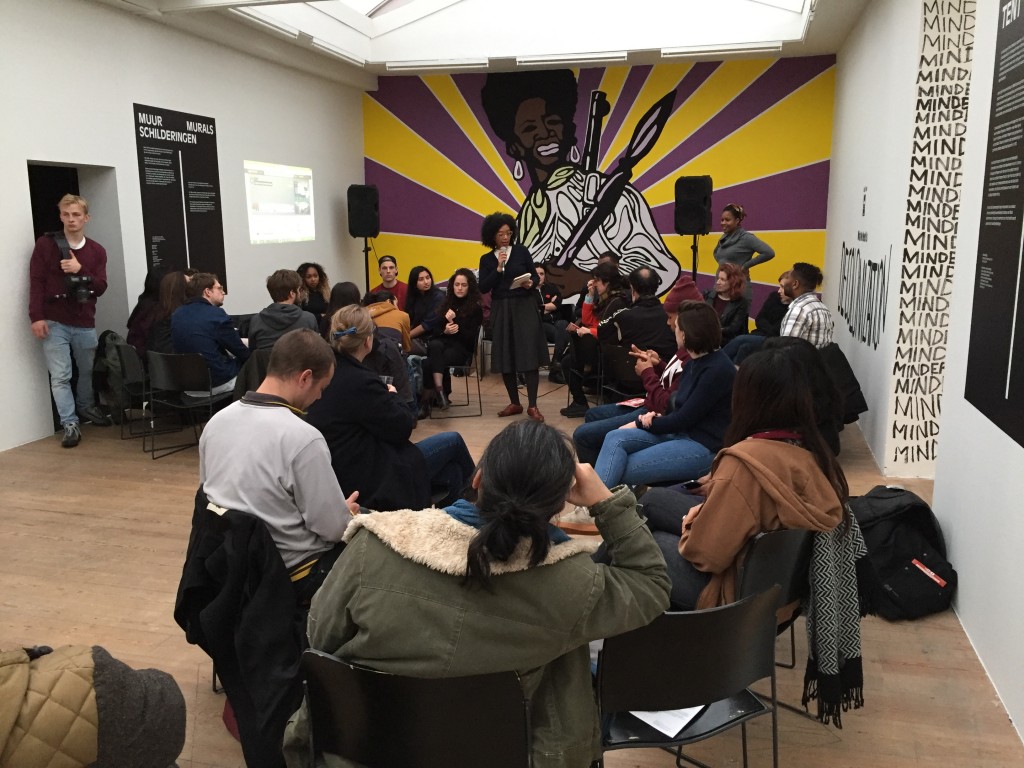Asia Art Archive is an international archive and research center based in Hong Kong. Asia Art Archive also produces exhibitions and publications in collaboration. By making unknown art historical materials—connected to artists works and activities, as well as sources about art events—accessible online, Asia Art […]
read moreThe Unvaried Repertoire
Artwork in Focus – OFF-Biennale Budapest special edition
A tree philodendron and other exotic plants, an Alaskan Malamute relaxing on the garden table, the sound of a synthesizer, a flute and an airplane, a swimming pool, a kitchen, a living room, a bookshelf in the background, South-American fabrics and an embroidered Hungarian pillow […]
read moreFrom Fake Mountains to Faith (Hungarian Trilogy) by Szabolcs KissPál
Artwork in Focus – OFF-Biennale Budapest special edition
OFF-Biennale Budapest is a grassroots, civil initiative, the largest contemporary art project of the art scene in Hungary in the last few years which is realized without applying for funding to the Hungarian state and without using state-run art institutions. After its first edition in […]
read moreExit into the Light by Nabil Anani
In 1987, what is now known as the First Intifada, i.e. the first uprising, broke out in Palestine. The Intifada was a culmination of many years of resistance against the Israeli military occupation of Palestine. It was characterized by acts of civil disobedience such as […]
read moreBack to Basics. Responses to the Issue Inside the Mezosfera
An Introduction to Issue #3
Taking the thematic issue Inside the Mezosfera (published in September 2016) as a point of departure, we have invited contributors to reflect on the themes that the preceding issue’s essays bring forward—including unlearning, independence, “unacademia, resistance, or walking theory”—as well as a concept of the mezosfera we have proposed. An overarching theme that has emerged in the texts are the contradictions and complexities of the state of independence, underlining the near omnipresence of the fragile, conflictual, and in-flux positions art and cultural workers assume.
read moreAgainst State Phobia, For Dis/Engagement
Reading the inspiring essays of issue #2 made me further reflect on what has been a longstanding preoccupation of mine, namely, the relationship between the arts/cultural production and the state, or, more specifically, between the mezosfera and the state. It seems to me that the question of how to dis/engage the state (and how to theorize this dis/engagement) is a crucial one for the cultural producers inhabiting the mesosphere. I will immediately lay bare my own stand: disengagement can only be a tactical one, a move within a complex war of position, and no long-term option.
read moreInternal Contradictions of Contemporary Independence and the Cultural Logic of the Latest Capitalism
The Mezosfera journal in its second issue invited us to think the “future scenarios now.” At first glance such an invitation may resemble the contemporary dictum future is now that forefronts the brutal forces of speculative capitalism, the financial-info economy and social consumption in the latest capitalism. However, the urgent mobilization of future scenarios here obviously means something else. It means to think the future beyond the notions of projection and postponing typical of the modernist-utopianist teleology of history and time, but it also means escaping the vicious circle of self-sufficient present-ism and now-ism of the contemporary experience regime, obsessed with the consumption of the present moment, with a momentariness of now. Mezosfera dares to claim that such “double escape” is possible.
read moreMixologists* of the Cultural Field
The second issue of Mezosfera takes as a starting point a poetically written introduction. The editors Nikolett Erőss and Eszter Szakács write with spatial awareness incorporated in their metaphors, helping the reader “see” the “space” they want us to read from—or in. The spaces that are generated in our mind's eye are defined by conditions that seem to apply to much of Europe today—an increasingly regulated context. They point out that “it is a lot harder to develop a truly radical form in practice than to be radical in writing about it.” The editors thus also highlight the conflict expressed between practice and theory (which came into full force in the context of art with the advent of Postmodernism in the 1970s and thereafter), and the authors of the issue respond with texts that discuss what I would like to call professional social practices.
read moreProphesying about Hope in Times of Atmospheric Uncertainties
Actually it is in the stratosphere where we are mostly working. We are privileged enough to get a bird’s-eye view, one which most people don’t have access to, burdened as they are with watching their steps, but we are constantly threatened to either be hit by a plane or to fall down with a speed that leaves us hallucinating, in both cases losing our stability and composure. Sometimes we get close to the chilling mesosphere. We get a glimpse of blue lightning and become fascinated by the solitude of these upper realms. We wonder what it would be like to explore this stratum more, which seems to consist of beginnings and ends, where meteors burn and auroras emerge. It is a brief glimpse though, as scientific research has had its funding cut in our post-socialist countries after its token role in the Cold War was over; therefore, no one knows how to build the special costumes for this kind of exploration.
read moreBetween Hope and Trap
On the State of Social Transition in Ukraine
The Greek prefix mesos, meaning intermediate or position in the middle, is representative of Ukraine today—a situation in flux—and also in line with other post-Soviet or post-socialist countries. It is worthwhile thinking about and responding to the repurposed notion of mesosphere put forward by the editors of the issue. Mesosphere, in a way, likewise articulates the socio-political, economic, and cultural conditions of these countries in transition that, since 1989–1991, have started to re-establish their identity.
read moreSeries. Multiples. Realisms. by Nicu Ilfoveanu
Artwork in focus
Series. Multiples. Realisms. is one of the few long-term projects that engage in the most direct way in the exploration of the rural environment in Romania, a space allegedly idealized and romanticized, on which the national(ist) imaginary draws upon.
read moreWithout Index by Ferenc Gróf
Artwork in focus
At first sight the idea of placing a painting that has been gathering dust in museum storage for more than fifty years and a novel that barely anyone has read for decades together in a contemporary art context seems bizarre. Such a project is strange in the current museological context of Hungary, even though the end of the 1950s, the period in which the works were created, may become topical once again because of similarities in the institutional limitation of intellectual freedom through political interference in power structures and in the reactions of intellectuals. The laying out of such parallels presents today’s audiences with a difficult task, even though appropriation, or the concept of détournement and variations on it, already have a history going back decades and are built into the toolkit of contemporary art. Ferenc Gróf, a Hungarian artist based in Paris, sought to take on this task in the Kiscell Museum of Budapest with the collaboration of the author of this text as a curator.
read moreFlags by Bálint Szombathy
Artwork in focus
In 1972 the artist Bálint Szombathy carried out a series of works under the title Flags – photographic documentations of performances that deconstructed the Yugoslav flag. The Yugoslav flag consisted of the French Tricolour, rotated by 90° and with a red star outlined in gold added in the centre. The colours of the Tricolour symbolized liberty, equality and fraternity, while the red star stood for the victorious revolution. The context for Bálint Szombathy’s Flags (1972) was the onset of stagnation within the alternative utopia of self-managed socialism.
read morePeople of No Consequence by Aslan Gaisumov
Artwork in focus
On a double-sided postcard that someone handed me in Grozny, the capital city of the Chechen Republic, a young, armed soldier gazes with pride into the distance. The boldly-colored image—in a design ubiquitous in a past, yet not so distant epoch–is complemented by the slogan: 23 Fievralia, Den' zashchitnika Otechestva [23rd of February, Defender of the Fatherland Day; former Red Army Day]. Yet, when you turn the postcard over, there appears another, very different image: from behind a wooden fence, greyish faces look out at us sorrowfully, fearfully. The same date, the 23rd of February, is also referred to as the date of the deportation of the Chechen and Ingush nations.
read moreMezosfera: Future Scenarios Now
An Introduction to Issue #2
In the Earth’s atmosphere, the mesosphere is the layer between the stratosphere, where the airplanes travel, and the thermosphere, where the spaceships fly. It is thus the strata that is the least impacted by human activity, and one which we like to think of as carrying hope. Taking this layer of the Earth’s atmosphere as a metaphorical point of departure, the magazine Mezosfera—with a fictitious “pan-Eastern European spelling”—sets out to look at, connect, and engage initiatives that can be conceived as working in the middle ground, in the mezosfera layer of our contemporary art and cultural world, in-between grassroots and institutionalized practices.
read moreThe “Independent” Condition
Perspectives on Eastern Europe’s Cultural Sector
It would be difficult to identify, within the post-1989 Eastern European landscape, another realm that has undergone an equally intense labor of dispossession and resistance, of redefinition and reconceptualization, than the realm of the “public:” the state and state assets, public life, public institutions, and the public space. There is hardly anything, at the same time, that challenged the public heritage of the socialist state more than the neoliberal understanding of the primacy of the “free,” “unconstrained,” private initiative.
read moreUndisciplined Unacademic Zone

Having recently had some time to indulge in guilty pleasures, I watched through four seasons of the Star Trek: Enterprise TV series, originally aired between 2001 and 2005. I enjoyed the show more than one might expect; nevertheless, I could not guarantee the same would hold true for someone who does not have a soft spot for science fiction. What is unquestionably interesting, however, for anyone trying to understand the dominating symbolic order we are all submerged in is an ideological reading of the series. Seen through the lenses of ideology critique, it turns out not to be about the future at all.
read moreWalking Theory
My interest in “walking theory” initially came from an education in art and humanities, which taught us that art was an intimate activity of the artist-genius who creates directly from his guts, while theory was an abstract speculation, which, if you let it come closer, can castrate artistic freedom. Paradoxically, all this was promoted in Belgrade in the 1990s, in the context of the civil wars in the former Yugoslavia, the international sanctions, the regime of Slobodan Milošević, and the transition from socialism to capitalism.
read more















